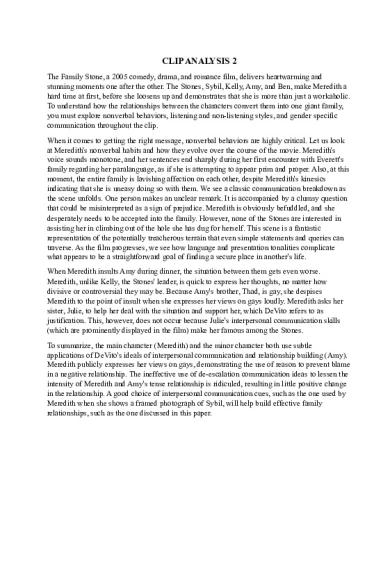CA 2 - this is a clip analysis for the movie the family stone. - Interpersonal Communication PDF

| Title | CA 2 - this is a clip analysis for the movie the family stone. - Interpersonal Communication |
|---|---|
| Author | harshi gangaraju |
| Course | Interpersonal Communications |
| Institution | Lindsey Wilson College |
| Pages | 2 |
| File Size | 59.8 KB |
| File Type | |
| Total Downloads | 1 |
| Total Views | 146 |
Summary
this is a clip analysis for the movie the family stone....
Description
CLIP ANALYSIS 2 The Family Stone, a 2005 comedy, drama, and romance film, delivers heartwarming and stunning moments one after the other. The Stones, Sybil, Kelly, Amy, and Ben, make Meredith a hard time at first, before she loosens up and demonstrates that she is more than just a workaholic. To understand how the relationships between the characters convert them into one giant family, you must explore nonverbal behaviors, listening and non-listening styles, and gender specific communication throughout the clip. When it comes to getting the right message, nonverbal behaviors are highly critical. Let us look at Meredith's nonverbal habits and how they evolve over the course of the movie. Meredith's voice sounds monotone, and her sentences end sharply during her first encounter with Everett's family regarding her paralanguage, as if she is attempting to appear prim and proper. Also, at this moment, the entire family is lavishing affection on each other, despite Meredith's kinesics indicating that she is uneasy doing so with them. We see a classic communication breakdown as the scene unfolds. One person makes an unclear remark. It is accompanied by a clumsy question that could be misinterpreted as a sign of prejudice. Meredith is obviously befuddled, and she desperately needs to be accepted into the family. However, none of the Stones are interested in assisting her in climbing out of the hole she has dug for herself. This scene is a fantastic representation of the potentially treacherous terrain that even simple statements and queries can traverse. As the film progresses, we see how language and presentation tonalities complicate what appears to be a straightforward goal of finding a secure place in another's life. When Meredith insults Amy during dinner, the situation between them gets even worse. Meredith, unlike Kelly, the Stones' leader, is quick to express her thoughts, no matter how divisive or controversial they may be. Because Amy's brother, Thad, is gay, she despises Meredith to the point of insult when she expresses her views on gays loudly. Meredith asks her sister, Julie, to help her deal with the situation and support her, which DeVito refers to as justification. This, however, does not occur because Julie's interpersonal communication skills (which are prominently displayed in the film) make her famous among the Stones. To summarize, the main character (Meredith) and the minor character both use subtle applications of DeVito's ideals of interpersonal communication and relationship building (Amy). Meredith publicly expresses her views on gays, demonstrating the use of reason to prevent blame in a negative relationship. The ineffective use of de-escalation communication ideas to lessen the intensity of Meredith and Amy's tense relationship is ridiculed, resulting in little positive change in the relationship. A good choice of interpersonal communication cues, such as the one used by Meredith when she shows a framed photograph of Sybil, will help build effective family relationships, such as the one discussed in this paper.
The relationship between individual variables and condition variables is the occurrence of provocation. Although the social environment is incredibly significant, it does not have the same impact on everyone. Not everyone becomes violent because they see aggression. You could be able to watch a lot of violent television and play a lot of violent video games without ever being violent. Violence happens when we believe that we are being threatened by others, and personality variables related to perceived danger predict aggression as well. People who are rejected by someone they care for are more likely to act aggressively. People who have a lot of negative impact, particularly those who see others as dangerous, are more likely to be violent. When these people see actions that may or may not be offensive in nature, they prefer to interpret it as threatening, and their hostility may escalate because of these impressions. Based on socioeconomic and cultural rules, social affirmation is a major source of violence. This is where an individual is praised by their culture for engaging in a particular action. Boys are supposed to be strong and courageous in our communities. They must demonstrate their determination by grabbing what they want with both hands. When a boy exhibits violent tendencies to achieve group leadership, he is rewarded with admiration. When a child shows a wish to be non-aggressive, he is often mocked. When it comes to gender and society, it is worth noting that most societies in developing countries regard aggressive men as powerful and attractive, while aggressive women are seen as derogatory or "bossy." This cultural difference between male and female recognition of violence may derive from a common memory held by all of mankind of males having to defend their families and search for food in the earliest days of humanity. First, in nine different nations, emotional and physical aggression had the same factor structure. Physical aggression was more common in some countries than relational aggression, while relational aggression was more common in others, and the mean levels of relational and physical aggression differed across countries. Second, even though boys registered more physical violence than girls in different countries, there were no gender disparities in emotional aggression. Third, higher rates of emotional violence were moderately to strongly associated with higher rates of physical aggression in all nine nations. Despite variations in mean levels of relational and physical aggression among nations, the results supported cross-country correlations in relational and physical aggression associations, as well as gender and aggression comparisons....
Similar Free PDFs
Popular Institutions
- Tinajero National High School - Annex
- Politeknik Caltex Riau
- Yokohama City University
- SGT University
- University of Al-Qadisiyah
- Divine Word College of Vigan
- Techniek College Rotterdam
- Universidade de Santiago
- Universiti Teknologi MARA Cawangan Johor Kampus Pasir Gudang
- Poltekkes Kemenkes Yogyakarta
- Baguio City National High School
- Colegio san marcos
- preparatoria uno
- Centro de Bachillerato Tecnológico Industrial y de Servicios No. 107
- Dalian Maritime University
- Quang Trung Secondary School
- Colegio Tecnológico en Informática
- Corporación Regional de Educación Superior
- Grupo CEDVA
- Dar Al Uloom University
- Centro de Estudios Preuniversitarios de la Universidad Nacional de Ingeniería
- 上智大学
- Aakash International School, Nuna Majara
- San Felipe Neri Catholic School
- Kang Chiao International School - New Taipei City
- Misamis Occidental National High School
- Institución Educativa Escuela Normal Juan Ladrilleros
- Kolehiyo ng Pantukan
- Batanes State College
- Instituto Continental
- Sekolah Menengah Kejuruan Kesehatan Kaltara (Tarakan)
- Colegio de La Inmaculada Concepcion - Cebu















